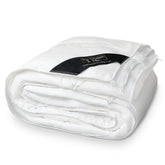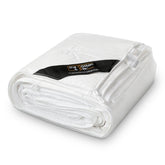Not Every Cotton Bedding Product Is Created Equal: Unveiling the Ultimate Guide to Luxurious Bedding
When it comes to creating the perfect sleep sanctuary, your choice of bedding plays a crucial role. Among the wide range of options available, cotton bedding stands out as a timeless classic. However, it's important to note that not every cotton bedding product is created equal.
How do you choose the best cotton-made bedding products you deserve? What type of fabric makes the best bedding sheets for you? What is thread count (TC)? Is it "the higher the better?"
Let's start with the raw material, cotton itself
There are basically two types of cotton - regular, and long-staple. Long-staple cotton has longer fiber that can produce better quality of yarn and fabrics. Egyptian long-staple cotton is the best in the world. But be careful, not all Egyptian cotton is long-staple cotton. The US (Pima cotton) and Xinjiang (a province in China) also grow long-staple cotton and are equally good with slightly different advantages from one another.
The next thing you need to know is Yarn Count
Yarn Count refers to the fineness of the yarn used, that is, the number of length twists in a pound of spun yarn. The most commonly used ones are 40s, 60s, 80s, 100s, etc., with 100s standing for the finest. Fabrics woven from the finest yarns are light and soft.
What is strand / ply?
Strand / Ply refers to the number of yarns contained in a thread. For example, single-ply fabrics are woven directly from a single-ply yarn thread, while double-ply fabrics are woven from threads twisted by two yarns. Microfine yarns can be twisted together to create double strands, resulting in thicker fabrics.
Last but not least, weaving techniques
Sateen and Percale are two typical fabrics that bedding products commonly use. They are produced by two different types of weaving structures.

Sateen is a fabric made using a satin weave structure - Warp (vertical) yarns are floated over weft (horizontal) yarns. For example, three over and one under. The sheen and softer feel of sateen is produced through the satin weave structure. The long floats of sateen produce a surface that is smooth to the touch and reduces light scattering to increase shine.
Percale is a fabric made of a one-over, one-under structure. It is the most common weave with 2 warp (vertical) yarns and 2 weft (horizontal) yarns intertwined with each other. This technique makes the fabric very strong, but it tends to wrinkle more than other weaves. The two sides of the fabric are the same with percale weave. Therefore, it is perfect for flat sheets.
Now we can talk about TC (thread count)
Thread count (TC) is determined by counting the number of threads or yarns used vertically and horizontally during weaving. A higher TC means more threads or yarns are packed into each square inch of fabric, resulting in a thicker fabric. However, it's important to note that this rule applies specifically to cotton yarns in weaving. Other materials, such as microfiber, or techniques, like knitting, may use different methods to measure fabric quality and thickness.
While a higher thread count is often associated with better quality, it's essential to consider other factors as well. Opting for a thread count between 200 and 400 can offer a perfect balance of softness, breathability, and durability. Be aware that some higher thread counts fabrics made from double-strand yarns can be thicker and less breathable.
In summary, the picture below summarizes how a typical weaving bedding fabric is made from cotton, and what types of cotton, yarn, threads are there. (Just to list a few, not all.)







